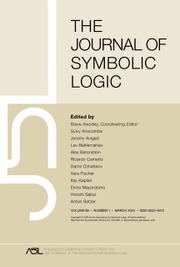Article contents
AN ANALYSIS OF THE MODELS  $L[T_{2n} ]$
$L[T_{2n} ]$
Published online by Cambridge University Press: 04 February 2019
Abstract
We analyze the models  $L[T_{2n} ]$, where
$L[T_{2n} ]$, where  $T_{2n}$ is a tree on
$T_{2n}$ is a tree on  $\omega\times \kappa _{2n + 1}^1 $ projecting to a universal
$\omega\times \kappa _{2n + 1}^1 $ projecting to a universal  ${\rm{\Pi }}_{2n}^1 $ set of reals, for
${\rm{\Pi }}_{2n}^1 $ set of reals, for  $n > 1$. Following Hjorth’s work on
$n > 1$. Following Hjorth’s work on  $L[T_2 ]$, we show that under
$L[T_2 ]$, we show that under  ${\rm{Det}}\left( {{\rm{}}_{2n}^1 } \right)$, the models
${\rm{Det}}\left( {{\rm{}}_{2n}^1 } \right)$, the models  $L[T_{2n} ]$ are unique, that is they do not depend of the choice of the tree
$L[T_{2n} ]$ are unique, that is they do not depend of the choice of the tree  $T_{2n}$. This requires a generalization of the Kechris–Martin theorem to all pointclasses
$T_{2n}$. This requires a generalization of the Kechris–Martin theorem to all pointclasses ${\rm{\Pi }}_{2n + 1}^1$. We then characterize these models as constructible models relative to the direct limit of all countable nondropping iterates of
${\rm{\Pi }}_{2n + 1}^1$. We then characterize these models as constructible models relative to the direct limit of all countable nondropping iterates of ${\cal M}_{2n + 1}^\#$. We then show that the GCH holds in
${\cal M}_{2n + 1}^\#$. We then show that the GCH holds in  $L[T_{2n} ]$, for every
$L[T_{2n} ]$, for every  $n < \omega $, even though they are not extender models. This analysis localizes the HOD analysis of Steel and Woodin at the even levels of the projective hierarchy.
$n < \omega $, even though they are not extender models. This analysis localizes the HOD analysis of Steel and Woodin at the even levels of the projective hierarchy.
Information
- Type
- Articles
- Information
- Copyright
- Copyright © The Association for Symbolic Logic 2019
References
REFERENCES
- 1
- Cited by

